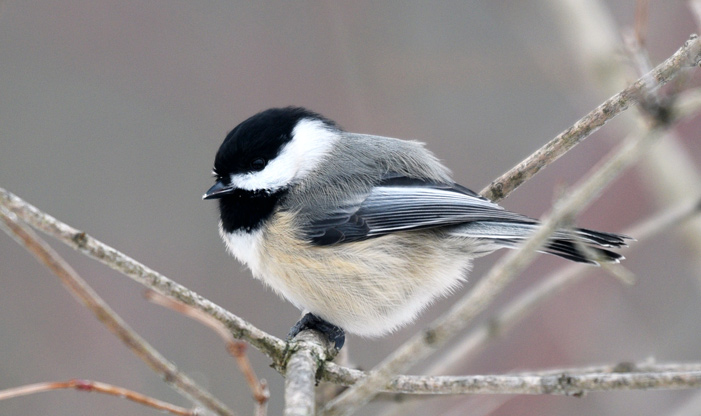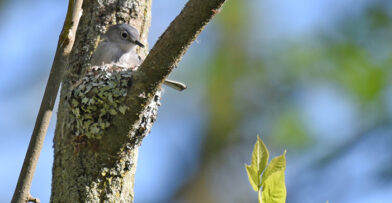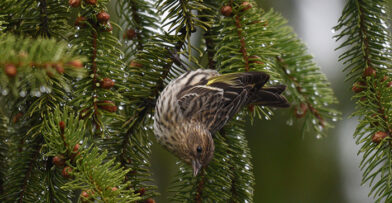Bird song is how most people first notice birds. If you’ve spent any time outdoors, you have definitely heard the sounds of several different birds singing. But, maybe it’s always been in the background. Although birds are some the most exquisite singers, learning their songs can be intimidating and overwhelming. Have you ever walked through the woods at dawn during the height of spring migration? The chorus is breathtaking, but many species have complex songs that can be tricky to distinguish. If you are where I am at with birdsong, you may find yourself asking, “Was that an American Robin or a Rose-breasted Grosbeak? Or could it have been a Baltimore Oriole or Scarlet Tanager?” If you look up recordings of their songs, you’ll hear what I mean.
Learning the Language
Experts suggest starting with the birds that hang around your neighborhood all year to learn birdsong and general identification. Do this in order to develop a baseline of knowledge. Just like learning a new language, you start with learning the alphabet, not suddenly writing a complex essay. We are going to take this idea one step further and focus only on one bird, the Black-capped Chickadee. There are other species that stay in Milwaukee through all seasons who are also beautiful singers. But, arguably none is more adorable than the chickadee.
Chickadees are a great place to start for a few reasons. They have one of the simpler and recognizable (but not less beautiful!) songs and calls. Chickadees have one general song, unlike some birds who have dozens of variations. Throughout their range, which is most of the upper half of the United States and all of Canada, their song and call are fairly consistent from state to state.
Although the chickadee has a simple song (2-3 syllables) and call, it is no less complex in meaning. Ornithologists are constantly studying what the songs, calls, and alarms indicate. It is an entire language that we will never fully understand, but there are some basics we can all grasp.
Songs
In general, if a bird is singing, it is either defending territory, trying to attract a mate, or communicating with a mate. In most species, the male is the only singer, but there are exceptions. Occasionally Black-capped Chickadee females will sing to communicate with their partner, as a way of saying “Here I am!” The chickadee song is a two or three syllable whistled “Hey, Sweetie” or “Fee-bee.” Although chickadees do not actually say the phrase “Hey, sweetie,” birders have come up with words or phrases which have a similar syllabic pattern to the bird song to help internalize the song, known as a mnemonic device.
Alarms and Calls
Birds communicate with each other to let the others know if danger is near, if food is near, and to stay in contact. Black-capped Chickadees have a few different calls to indicate different levels of danger. They actually get their name from their alarm call, an onomatopoeia, chick-a-dee-dee-dee. The number of “dees” that follow the “chick-a” indicate to the rest of the flock the intensity and proximity of danger. If a chickadee is warning the rest of the group of a perched Great-horned Owl (who is not generally a predator of chickadees), he may use four “dees” after the “chick-a.” But, if a Sharp-shinned Hawk (a main predator of chickadees) is perched nearby, it could have seven additional “dees.” Researchers have found that depending on the danger, somewhere between five to twenty three “dees” can be added.
And, if that Sharp-shinned Hawk starts moving, a high but quiet “Tseet” call will go out from a male telling everyone to freeze in place, because danger is imminent. Once danger has passed, a male will give an “all clear” chick-a-dee-dee-dee. It lets the flock know they can go about their business again.
Tips for Learning Bird Song
Now that we have covered the basics of the Black-capped Chickadee, you may be ready to begin learning the songs and calls of other birds. The audio set Peterson Field Guides: Birding by Ear by Richard K. Walton and Robert W. Lawson is a great intro to bird song. Stokes Field Guide to Bird Songs: Eastern Region by Donald Stokes is also another audio set that is widely used by birders.
Merlin Bird ID is an app that contains songs, chirps, and calls of hundreds of birds throughout North America. You could repeat a song repeatedly until it sticks. Visit Cornell’s Lab of Ornithology website and play “Bird Song Hero,” a bird song learning game they developed.
In the Field
Find an experienced group of birders with whom to go birding. They will be helpful in pointing out songs if you ask, and birders are generally friendly, helpful teachers.
If you are out in the field and do not have any of these resources handy, I’ve learned to write down what I’m hearing, and try to look it up later. Write how many syllables you hear, how many seconds of silence are between the start of each song, and scribble any “phrases” that you may hear the bird saying. Some websites and field guides contain mnemonic phrases, so it could aid in an ID!
And finally, one of the best ways to learn bird song is to spend time in nature, actually listening to the birds. It may not come easy, but don’t give up! It can be a tricky skill to learn, but as you begin to recognize birds by their voice, you will feel connected to nature in a whole new way.


